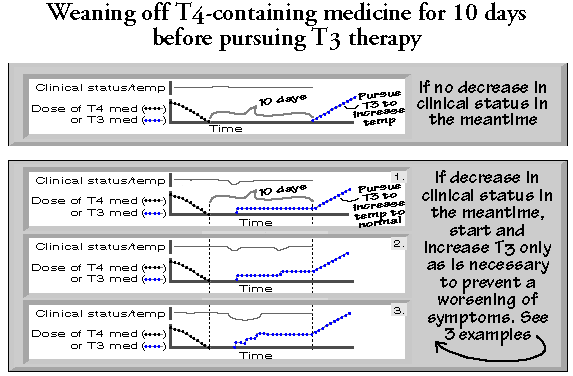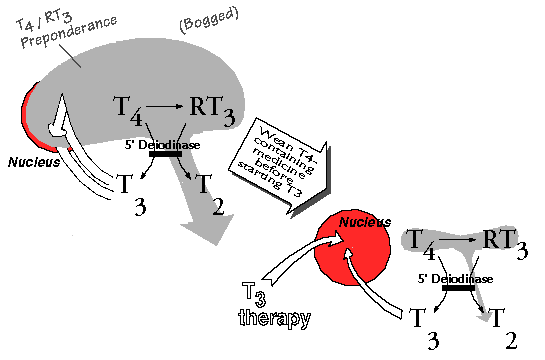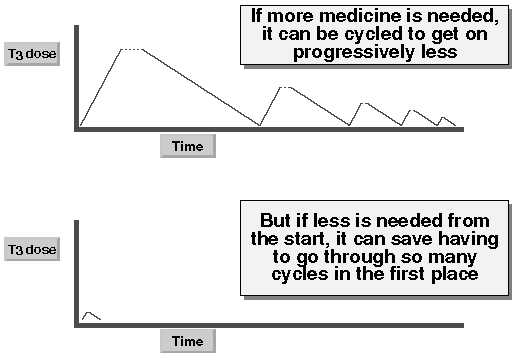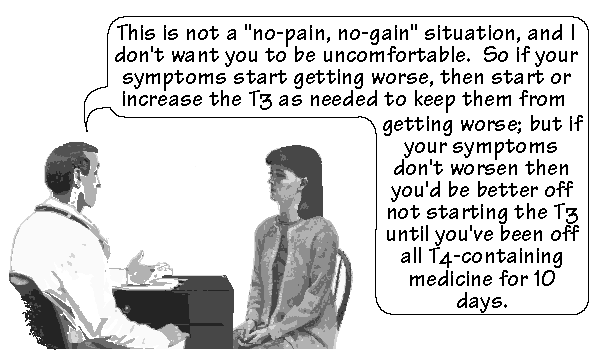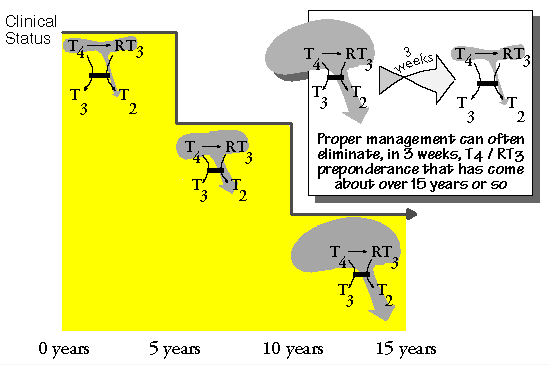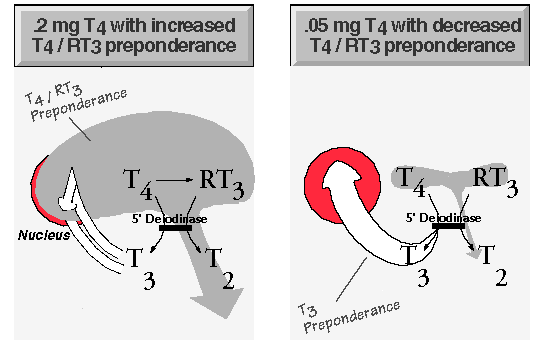|
Hypothyroidism is low thyroid gland function. But the symptoms of low thyroid system function are more commonly caused by Wilson’s Temperature Syndrome, not hypothyroidism.
|
People diagnosed as hypothyroid who are taking T4-containing medicine may never have been hypothyroid, or if they were, may not be now.
By hypothyroid I mean those patients who actually have low thyroid gland function.
Not everyone who has been diagnosed as hypothyroid is hypothyroid.
And even if they were hypothyroid at one point does not necessarily mean that they are hypothyroid now.
Patients who have been diagnosed as hypothyroid in the past based on clinical parameters may have been suffering from Wilson’s Temperature Syndrome and not hypothyroidism. By far, most people who are clinically hypothyroid and who have thyroid-responsive symptoms are suffering from Wilson’s Temperature Syndrome and not hypothyroidism.
So patients who present on T4-containing medicines with a past diagnosis of hypothyroidism, may not actually be hypothyroid.
Some people are hypothyroid. It is helpful to obtain as much of the past medical studies and tests upon which the patients’ diagnoses have been made, so that nothing gets lost or changed in the translation. But if these are no longer available, always take thyroid diagnoses with a grain of salt.
|
Patients who do have hypothyroidism can also be suffering from Wilson’s Temperature Syndrome.
|
Even hypothyroid patients well replaced with T4-containing medicine to the satisfaction of blood tests can still have low temperatures and suffer from severe symptoms of low thyroid system function.
Patients who are hypothyroid and who are well replaced with T4-containing medicines to the satisfaction of blood tests may still be suffering from Wilson’s Temperature Syndrome. If their temperatures are low, and they are still suffering from their familiar symptoms of hypothyroidism, they may not be converting the T4 well enough to provide sufficient T3 stimulation of the cells (p51).
I had one patient who presented to the office taking .3 mg of T4. She had a T4 level of 18 mcg/dl and a TSH of .2 mcIU/ml, yet her temperature ran over a degree below normal, and she had severe symptoms of low thyroid function.
This patient was weaned off the T4 and started on T3 therapy. Her symptoms resolved when her temperature was brought to normal. Her presentation and response to T3 therapy are classic.
This type of presenting history and response to treatment is very common.
It’s best to wean and remain off T4-containing medicine for ten days before starting T3 therapy. But if a patient’s symptoms start to worsen the T3 should be started before the ten days have passed. The T3 can even be increased during the 10-day period but only as is necessary to prevent a worsening of the symptoms.
When a patient presents with a low body temperature and symptoms of low thyroid system function, in spite of being treated with a T4-containing medicine, and a therapeutic trial of T3 is contemplated, it is best to wean the T4-containing medicine before beginning the T3 therapy.
Ideally, I prefer the patients to not begin T3 therapy until they have been off T4-containing therapy for at least 10 days.
I hasten to add, however, that they are to be reassured, that if they begin to worsen clinically, the T3 therapy will be started before the 10 days have passed, and increased one increment as often as every day, as is necessary to prevent a worsening of their symptoms.
To repeat, for that 10 day period the T3 therapy is not to be increased (or started) in an attempt to raise the patients’ temperatures and to improve the patients’ symptoms, but only as needed to support the patients clinically, to prevent a worsening of their symptoms.
After the 10 day period has passed then one may “chase” the patients’ temperatures by increasing the T3 therapy as often as every day according to protocol in an attempt to normalize their body temperature patterns.
Weaning T4 decreases the T4/RT3 preponderance that competes against T3 at the level of the receptors.
There is a good reason for the above recommendations. When patients present with Wilson’s Temperature Syndrome, they are in T4/RT3 preponderance (p50). This is even more the case if the patients have been pushed too far in the wrong direction with the wrong (a T4-containing) medicine.
If there is a T4/RT3 preponderance the T4 certainly, and perhaps the RT3 to a smaller extent, will compete with any exogenous T3 administered at the site of the nuclear membrane receptors in the cells. So from the start, more T3 will be needed to generate the same amount of thyroid stimulation of the cell than would be needed if there was no T4/RT3 preponderance.
This would call for higher doses of T3, which are harder to keep steady. But the people that always do the best on the treatment are the ones that are lucky enough to get their temperatures up on the smallest levels of the medicine.
Generally speaking, the patients who have had their temperatures captured (p75) on smaller doses of the medicine are closer to being finished with the treatment. This is because T3 therapy involves cycling the patients on and off the medicine to get them closer and closer to normal, on less and less medicine, until they’re normal off medicine. Thus, some patients who get on higher levels of medicine will just have to cycle on and off one or more times to be as far along as they would have been had they not needed the higher doses. And cycling on and off the medicine takes time (each cycle can take over a month).
By weaning the T4-containing medicine first patients are often able to capture their temperatures on much lower dosages of T3, thereby saving them as much as six months worth of therapy.
However, by weaning off the T4, while staying on the smallest dose possible of T3 (preferably none) for 10 days before chasing the temperature, the T4 and RT3 are given a chance to go out of the system, thereby depleting the T4/RT3 preponderance, and the competition against T3. Looking at the half-life of T4, this process is not complete within 10 days, but I feel it is sufficiently complete for therapy to be started (purists may want to wait 14 – 17 days or more).
By letting the competition against T3 diminish, the patients are often able to capture their temperatures on much lower dosages. In this way, the patients are able to get their temperatures up from the start on much smaller doses than if they had started increasing the T3 therapy sooner against more competition, perhaps saving themselves several cycles and months worth of treatment.
Thus, even though it is often hard for the patients to hold off chasing the temperature with T3 for the 10 days T4 and RT3 levels are being depleted, it’s important for them to know that by doing so, they can often be as far along in 3 weeks as they otherwise might be in six months if they don’t.
I say 3 weeks, because the 10 day period does not begin until the patient is actually off the T4-containing medicine–which may itself need to be weaned in stages over a few days, depending on how much the patient is taking.
If necessary, the T3 can be started to support the patient in the meantime.
If the patient’s on .075 mg of T4, I might stop the T4 in one step if the patient does not appear to be brittle (a clinical judgment). Otherwise, I might cut the dose in half for two days and then discontinue it. If the patient’s on around .3mg, I might recommend going down a third (.1 mg) every 2 days until it is discontinued. Generally, the less constitutionally resilient a patient appears to be (again clinical), the more gradually I wean the T4-containing medicine. However, I don’t usually like to go any more slowly than I have to, because the longer it takes to wean the patient off the T4, the longer it will be before the 10 day period begins, and I don’t want the treatment to take unnecessarily long. Also, I am not very concerned about the patient weaning off the T4 because I know we’ll have T3 “waiting in the wings” to come in and support the patient if necessary.
Patients should be reminded and reassured that should they worsen at all clinically during the weaning process, before T3 therapy is used to chase the temperature, that the T3 can be started to support them if needed. But again, it should be stressed that it would be in their best interest to remain off the T3 if possible.
However, be careful because some patients having been told this will stay off all T3 for the 10 days in spite of worsening, to the point of having a hard time with normal daily functioning. It is good to counsel against this extreme. It’s not a “no pain, no gain” situation, and there is no need for patients to be uncomfortable. If during the 10 day period they begin to feel more clinically hypothyroid, they should start on the smallest dose, and increase it as needed to prevent them from getting worse. They just shouldn’t start it, or increase it, in an attempt to feel any better until the 10 days have passed.
Far more people are able to stay comfortably off all thyroid for the 10 days than you might expect. Many patients are surprised that they are able to stop all thyroid medicine and stay off for 10 days and tolerate it as well as they do. Most patients don’t need to start any T3 during the 10 day period, but are able to hold their own.
It is worth emphasizing the degree of progress that is often made during the 10 day period. By starting the treatment in this manner, the patient can almost completely reverse in a matter of 3 weeks what has perhaps taken years to develop, thereby giving the patient a virtually fresh start.
This is especially encouraging in cases where patients have been pushed too far in the wrong direction with the wrong medicine. If the treatment is started in this manner, all the negative progress can be all but eliminated in a few weeks, so the patient is better prepared to make positive progress.
If it is not perfectly evident whether or not the patient is hypothyroid, when one weans the T3 therapy, one may do so without adding back any T4 supplementation to see if perhaps the patient can maintain normal body temperature patterns without T4 or T3 supplementation.
If the conditions are not favorable to challenge the patient, or it is clear for one reason or another that the patient definitely does not have any thyroid gland function (e.g., thyroid gland has been surgically removed), then while the patient is being gradually weaned off a cycle of T3 therapy the patient must be supported with T4 supplementation (see possible exception below).
Exception: In cases where another cycle of T3 therapy is to be started once the present cycle is weaned, one may be able to avoid adding back any T4 between cycles (if the patients remain comfortable) even in patients who are somewhat hypothyroid. The reason one might want to consider this is because if one does add back T4 while one cycle of T3 is being weaned, it is usually best (once that T3 cycle has been weaned) to have the patients wean back off that T4 , and not start the next cycle of T3 for 10 days (as described above), if comfortable. Thus, one may be able to save some treatment time if one is able to comfortably avoid having to add back the T4 between cycles in the first place.
Less T4 “better” converted provides more stimulation than more T4 “worse” converted.
As stated previously, many patients who have been diagnosed as being hypothyroid in the past, may never have been, or if they were, may no longer be. And after cycling through T3 therapy, they may feel better off all thyroid medicine than they ever did on it. But even the patients who are hypothyroid, and who need some sort of T4 support (after cycling through T3 therapy), can often get more T3 stimulation out of less T4 than they were previously getting out of more.
When T4 supplementation is added back, it is best to try much lower levels first, before returning to the patient’s original level of T4 supplementation. For example, if a patient presented on .2 mg/day of T4, it would be good to add back only about .025 mg/day of T4 when you start weaning the T3 , and increase the T4 only as needed to support the temperature (especially if she has a history consistent with being pushed in the wrong direction).
Many patients who present on doses as high as .2 mg of T4 can often enjoy much better temperatures and clinical status on .05 mg of T4 than they ever did on .2 mg, after they have been cycled through T3 therapy. Presumably because the T3 therapy eliminates the T4/RT3 preonderance such that the T4 conversion and T3 stimulation of the cells is much “cleaner,” or more efficient.
I see a benefit in the patient being replaced with the smallest amount of T4 as is functional. The taller the tree the harder it falls. And the more unnecessarily high the T4 level, the more opportunity there is for stressful circumstances to shunt much of it to RT3, and the more opportunity there is for the shunting to get stuck that way due to T4/RT3 preponderance.
The taller the tree the harder it falls. A stress can trigger a vicious cycle that can cause a build-up of T4/RT3 preponderance. Higher doses of T4-containing medicine can lead to faster build-ups after a triggering stress.
Interestingly, the most precipitous onsets of Wilson’s Temperature Syndrome have often been in patients who had gotten up on large doses of T4-containing medicines, and then experienced a triggering stress.
Also, if patients relapse when they are on .2 mg of T4 when .05 mg would have been sufficient, those relapses are likely to be more severe, and more difficult to correct, than they would have been if they were on .05 mg.
A patient who is being supplemented with a combination of T4 and T3 therapy is more likely to experience a decline in clinical status when presented with a physical, mental, or emotional stress than is a patient who is well replaced on T3 therapy. This is because a patient’s T3 supply is more dependent on T4 to T3 conversion by the deiodinating enzyme when the patient is taking some T4.
Given these observations, some might wonder if it would be better to leave hypothyroid patients on T3 therapy, rather than to put them back on T4. Not usually. When T4 is working (temperature’s normal, patient feels well), it’s an excellent choice. It’s once-a-day, ubiquitous, inexpensive, well-tolerated, familiar to all, and has a long half-life. I prefer T4 for long-term maintenance of hypothyroid patients. When the T4 is not working, however, one might be constrained to consider putting the patient on T3 therapy for a time to “clean out” or reset the system.

